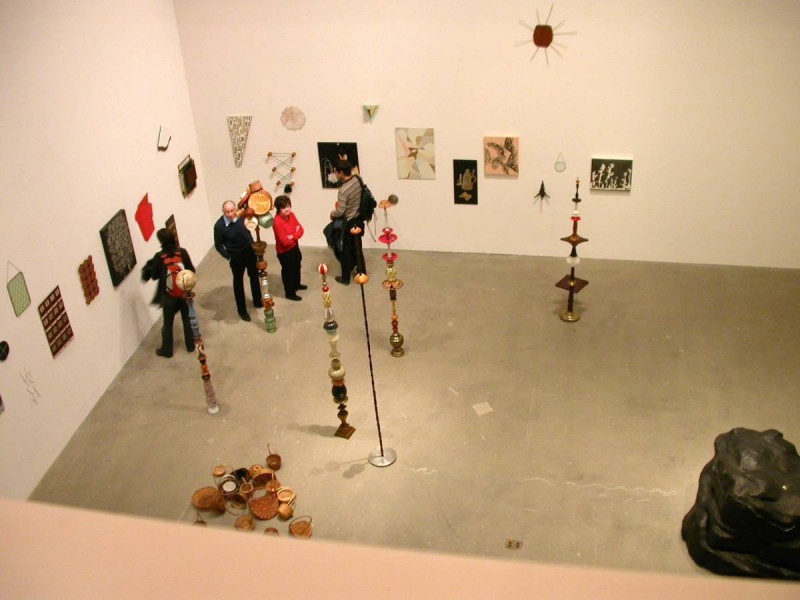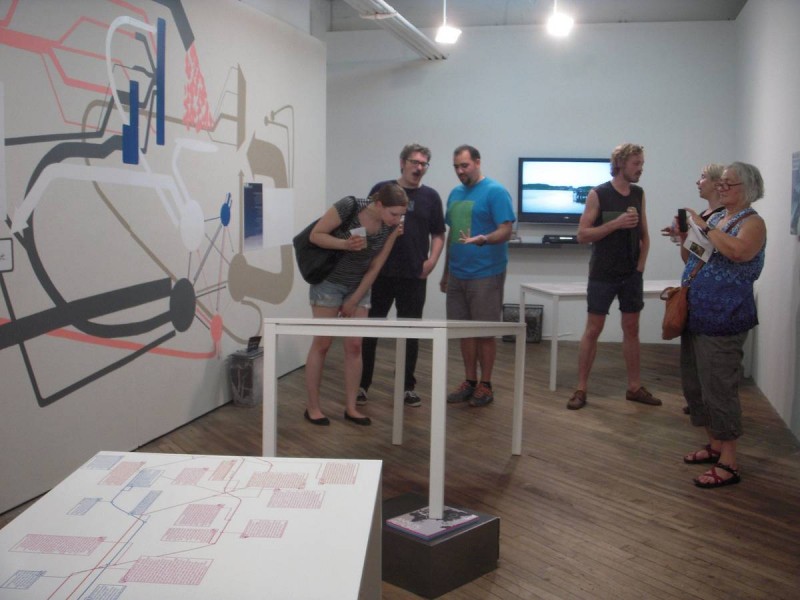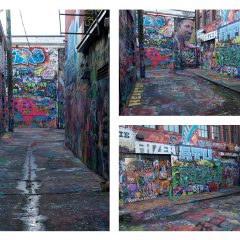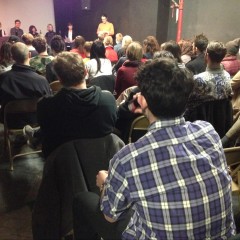When on-line art-blogs and journals amass a great deal of material, they often use a system of categories (otherwise known as metadata) to catalogue the material; common examples are ‘Exhibition Reviews,’ ‘Artist Interviews,’ ‘Letters to the Editor,’ etc. Such categorization makes perfect sense: it provides a useful organizational mechanism, thus making it easier for both the editors and the potential reader to negotiate the archives of material. But, is the act of categorization a neutral mechanism?
The answer to this question does not seem so clear when the categorization of theoretical writings is concerned. In the following remarks, I want to shed light on the problem of categorization of theory by attending to the Artblog’s category “Theoretically.” I will argue that, as a construction of a platform on which to showcase ‘theoretical writings,’ “Theoretically” strips theory of its central role in the discourse of art.

Here in Philadelphia
To state that ‘theory’ is a term that sometimes divides an art community is not without some justification. Here in Philadelphia, this division is revealed in the way in which art is discussed, especially in relation to the notion of art criticism. The idea that ‘there isn’t any criticality in Philadelphia’ has become a sort of leitmotif. We often hear a plea for more critical engagement. As a response to the plea, platforms have been provided on which criticism can be staged, such as the Artblog’s launching of “Theoretically” in 2009, a space in which theoretical writings are showcased. [Ed. note – See here for background on the 2009 Junto that resulted in Theoretically.]
There are two aspects that form, I believe, the hidden presuppositions of “Theoretically.” First, ‘criticism’ is identified with ‘theory’ (and, even worse, both are often identified as ‘academic’). And second, ‘theory’ is structurally isolated from other forms of writing about art, especially from the most popular form in the Artblog, namely the category of “Reviews, Features & Interviews.” Unfortunately, I will not have time to go into the first point, although I think it should be addressed since ‘theory’ and ‘criticism’ are not the same and their distinction needs to be grasped. I will, instead, focus only on the second point.
A ‘theory,’ broadly construed, is a system of general propositions, axioms, laws and ideas that try to explain the meaning and structure of something. These general laws are, in some sense, absolutely foundational, thus providing the basis from which all other laws or ideas are derived. The way in which ‘theory’ is proved is through the verification of measurement. Measurement calculates the accuracy of the correspondence of the theory and the thing that the theory is trying to explain. In the context of art, however, we seldom speak of a ‘general principle’ that tries to provide the explanation to the thing called ‘art.’ There is no formula that states ‘X + Y = Art.’ We do not, then, understanding ‘theory’ in relation to art in terms of an attempt to provide a scientific system that will comprehend the thing ‘art’ in its absolute totality, that is, regardless of time, space or material. This is because we understand art as an aspect of our cultural life; and because of this, we see it as something that, like life, is constantly changing. Importantly, art is not an object that can be ‘verified’ in so far as it is not an ‘object’ in the scientific sense. Rather, it emerges as a consequence of a set of relations between people, histories, institutions and discourses at specific moments in time.
Consequently, ‘theory’ in the context of art is usually seen more as an ‘attitude’ or a ‘way of thinking’ that does not necessarily aim at establishing eternal formulas, but rather aims to express what happens when art is experienced. What makes our experiences ‘theoretical,’ however, is not concerned with the relaying of what we ‘see’ or what we ‘feel’ when we look at a work. As it is usually understood, ‘theory’ is reserved almost exclusively for a way of thinking that wants to talk about ‘deeper’ things via a fascination with the latest conceptual trends (more often than not, ones that come out of France). In this sense, ‘theory’ is understood as a way of thinking that is related to other modes of thinking, especially philosophical ones. This conversion of ‘theory’ to a loosely defined philosophical field is instrumental in the vindication of another mode of thinking, what one could call ‘aesthetical.’

On the ‘Theoretical’ and ‘Aesthetical’
The identification of two ways of experiencing art, ‘theoretical’ and ‘aesthetical,’ presupposes a division of the experience of art into ‘different ways of experiencing.’ Is this division justified? Let us consider it from the side of the ‘aesthetical.’
When one experiences a work of art and states that it is ‘beautiful,’ ‘poignant’ or ‘haunting,’ one is using words that not only describe a certain inner feeling, but describes them in such a way that the meaning of the word used is given as absolutely self-evident, thus in need of no elucidation. When, for example, we speak of a painting as ‘haunting,’ the word reflects an inner feeling of eeriness, that is, evocative of something ghostly and unsettling. Nothing else really needs to be said. Take the following, for example, from a recent review in the Artblog:
“Jotted-down cursive complements the menagerie of flora and fauna; poetic definitions of “entanglement,” “saint,” and “martyr” make appearances, and when coupled with Conn’s sweet, lively, and whimsical paintings, they create an effect that truly reaches into your chest and pulls at each individual heartstring.”
(Before we examine this passage let me make one thing clear: I do not use this example because it is somehow unique. Rather, I simply clicked on the first review that appeared on the Artblog – accessed August 28, 2015. It is isolated, therefore, not in order to make an attack on the reviewer or the review, but to highlight the division that splits how we normally understand the experience of art.)
In the case of the quote above, what we have is a depiction of ‘aesthetical’ experience. The reviewer notes that paintings, when coupled with ‘poetic definitions’ of certain terms, create such an effect that they move the heart. The ‘aesthetical’ experience is lyrical (‘heartstrings’ are pulled). It understands art as something that ‘reaches out’ and ‘touches us.’ This understanding is by no means an idiosyncrasy of the reviewer. In an on-line response to a reader’s incredulity of the use of the word ‘puzzlement’ as a description of an experience of an exhibition at Vox Populi in December 2008, ‘roberta’ (presumably Roberta Fallon of the Artblog), in defense of the use of the term, made the following declaration: “When…complicated art doesn’t give me a way in at all or give me something to hook on to–some beauty or ugliness or something that touches a nerve — then it seems like it doesn’t want to talk to me, and so I am inclined to say, ok, I’ll look elsewhere.” For the ‘aesthetical’ attitude, to be ‘touched’ is almost an absolute prerequisite for engagement with art.
And yet, when the artwork successfully makes contact with the reviewer – as in the example of the passage above – something strange seems to happen: we end up in a realm of infinitely recycled descriptive platitudes. When a review expresses itself in stock catch-phrases, it inevitably fails to properly depict what the reviewer actually experienced. How so? The platitude (‘pulled heartstrings’) is so generic, it is emptied of the capacity to say anything specific.
This failure, despite what some people might think, has nothing to do with the energy, intelligence or literary capacities of the reviewer. Rather, it is a direct effect that comes along with the ‘aesthetical’ attitude and, more importantly, when this attitude is positioned against the ‘theoretical’ one. What I mean by this is the following: the ‘aesthetical’ attitude does not need to legitimize itself in any way since when a reviewer feels ‘touched’ by an art work, the content of their experience is, as I noted above, self-evident. When, however, the ‘aesthetical’ attitude is forced to legitimize itself – that is, when it is asked to push past its most basic aesthetical experiences and develop its feelings further – it recoils in a cunning way by elaborating a distinction from another attitude, namely a ‘theoretical’ one. In this way, the ‘aesthetical’ attitude shields itself against any criticism, by which I mean the necessity to legitimate its position, and opts instead to formulate a difference from a more ‘conceptual’ or ‘critical’ attitude, that is, one that has more to do with ‘cerebral’ or ‘intellectual’ experiences. ‘Being critical’ is to be ‘untouched’; ‘being critical’ is thus converted into ‘being theoretical.’
It is only the ‘aesthetical’ attitude that creates this division, since the ‘theoretical’ one, if actually theoretical, recognizes that the ‘aesthetical’ moment in the experience of art is a crucial part of the art experience and not one that is either excluded or added on at the end. The upshot of this is not that the ‘theoretical’ position is more ‘sophisticated’ than the ‘aesthetical’ one. Rather, it is that the ‘aesthetical’ attitude is, whether it realizes it or not, always ‘theoretical.’
An example of this is clearly illustrated when one naively asks what ‘being touched’ means. ‘Touching’ in either its figurative or literal sense is, at bottom, a concept when used to talk about our experiences. As a concept, it functions as a stand-in in for the actual experience. But, it also makes us think of something beyond the ‘thing’ that is merely substituted. When, for example, an artwork ‘pulls our heartstrings’ it does not just pull them for the sake of pulling them; rather, it makes us reflect on things that are not immediately present in the work as it stands before us, for example, things such as the work’s relation to the dimensions that make up our present context (be they economical, political, social, etc. dimensions). How do we make sense of this ‘other thing that is not present but is nevertheless expressed’ in art? This is where an ‘aesthetical’ attitude has to admit its limits and become ‘theoretical.’

The Necessity of Self-Reflection
Does not “Theoretically” try to affirm this? To provide a space for ‘theory’ by way of its categorization, however, is to construct an obstacle that suspends two things: first, our understanding of the existence of the ‘theoretical’ that is already and unavoidably at work in any ‘aesthetical’ attitude; and second, to make ‘theory’ something that happens in its own restricted realm, without proper relation to all experiences of art. The second point is, I would argue, a consequence of the first. A simple point can be made to show how. Note that since its inauguration in May 2009 “Theoretically” has published only nine posts. This, of course, is a remarkably small number considering “Theoretically” has been operational for well over six years. Why such a shortage of posts? More importantly, why such a shortage when (1) it does not strike me that there is a shortage of people capable of writing texts fit for publication on Artblog and (2) that the editors of Artblog are policing submissions in such a way that it radically restricts the number of postings?
I do not think it is wise to believe that the decisive reason for the lack of ‘theoretical’ posts is because ‘no one wrote anything,’ and therefore unwittingly providing perverse proof that ‘theory’ (and ‘criticism’) has no place in the Philadelphia art scene. I do not think it is wise to think this even if it is indeed the case. Why? I think there is something deeper at work that has generated a certain resistance to ‘theory’ on a general cultural level, one that is much larger than the development of art in Philadelphia. I think that this ‘resistance’ is an effect of a broader and deeper cultural attitude that has developed over the last thirty years in such a way that it does not allow us to see what is important about criticism or thinking ‘theoretically.’ One of the ‘causes’ of the emergence of this attitude is the institutional fixing of ‘theory’ as a university discipline. Another reason is more complex and would require significantly more time to explain, but, to put it very simply, it has to do with the cultural effects of the most dominant logic that structures the way we exist in the US at the moment, namely the logic of capitalism.
The cultural attitude that has developed over the years, to draw the main point from the two ‘causes’ posited above, is not created as an ‘agenda’ by some clandestine clique that, to play on the motif above, ‘pulls our mind-strings.’ Thus, in case anyone had the following in mind, I absolutely do not think the editors of the Artblog are ‘responsible’ for the scarcity of theoretical or critical thought.
I do think, however, that as the most popular and prevalent place in which the dynamics of the Philadelphia art community is showcased and discussed, the Artblog has a responsibility to reflect on the way it develops itself in relation to the mechanisms it uses and puts forward, one of which, as I have tried to show in these reflections, is the construction of “theoretically” as a reaction to the experience of the lack of ‘theoretically’ informed writing in Philadelphia. Moreover, I believe it has a responsibility to try to cultivate a more informed and self-reflective relation to art in Philadelphia. One way of doing this, as I hope I have shown above, is to reflect on the presuppositions that underpin the way we understand things.
–With the assistance of Michael Ciervo and Sid Sachs, Hammam Aldouri is currently leading a public seminar series on modern philosophy and art theory at Rosenwald-Wolf Gallery. For more information, please see https://www.facebook.com/uarts.rwg.









